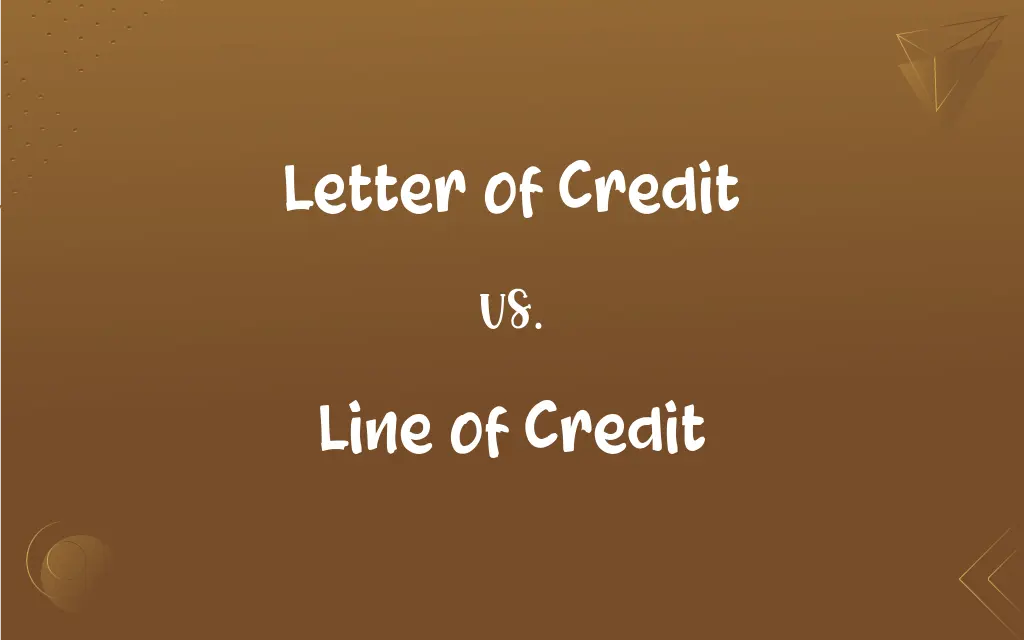Letter of Credit vs. Line of Credit: What's the Difference?
Edited by Aimie Carlson || By Janet White || Published on December 5, 2023
A letter of credit is a bank's guarantee for a buyer's payment to a seller, while a line of credit is a flexible loan from a bank to a borrower.

Key Differences
A letter of credit is primarily used in international trade to ensure that payments are made on time and for the agreed amount. A line of credit, however, is more like a flexible loan offering the borrower access to funds up to a certain limit.
In a letter of credit, banks act as intermediaries between buyers and sellers, guaranteeing payment under specific conditions. Whereas, a line of credit is a direct agreement between a bank and a borrower, where the borrower can draw funds as needed.
The letter of credit reduces risk in international transactions by providing a guarantee of payment. While, lines of credit manage risk by setting a credit limit based on the borrower's creditworthiness.
Letters of credit are commonly used in large, international trade transactions. Lines of credit are more versatile, used by individuals and businesses for various needs, including emergencies and short-term financing.
Letters of credit ensure that sellers receive payment, provided all terms are met. Lines of credit offer flexible financing but may lead to debt if not managed properly.
ADVERTISEMENT
Comparison Chart
Purpose
Guarantee payment in international trade
Provide flexible borrowing options
Users
Used by buyers and sellers in trade
Individuals and businesses for varied needs
Nature of Agreement
Between buyer's and seller's banks
Between borrower and lending institution
Payment Terms
Payment guaranteed on fulfilling specific conditions
Borrower decides when to use funds
Risk Management
Reduces payment risk in transactions
Credit limit set based on creditworthiness
ADVERTISEMENT
Letter of Credit and Line of Credit Definitions
Letter of Credit
Used to facilitate foreign trade.
The importer provided a letter of credit to gain the exporter's trust.
Line of Credit
Revolving credit for ongoing use.
The company’s line of credit helped during low revenue periods.
Letter of Credit
Ensures payment under specific terms.
A letter of credit was necessary for the overseas deal.
Line of Credit
Borrowing limit set by a lender.
Their business managed cash flow using a line of credit.
Letter of Credit
Financial instrument in international trade.
A letter of credit assured the exporter of timely payment.
Line of Credit
Accessible funds up to a certain amount.
He drew from his line of credit for home renovations.
Letter of Credit
Bank guarantee for trade payments.
The company used a letter of credit for their international supplier.
Line of Credit
Borrowing option with variable interest.
They preferred a line of credit for its flexibility.
Letter of Credit
Bank's commitment to pay the seller.
Their transaction was secured with a letter of credit.
Line of Credit
Flexible loan from a bank.
She used her line of credit to cover unexpected expenses.
FAQs
When is a letter of credit used?
Primarily in international trade transactions to guarantee payment.
Is a letter of credit a loan?
No, it's a guarantee of payment, not a direct loan.
How does a line of credit work?
It allows borrowers to access funds up to a set limit and repay over time.
What can a line of credit be used for?
Anything from business expenses to personal emergencies.
What is a letter of credit?
It's a bank's promise to pay a seller on behalf of a buyer in international trade.
What's needed to obtain a letter of credit?
A buyer's request and sometimes collateral or a deposit.
What’s the interest rate on a line of credit?
It varies and is often based on the prime rate plus a margin.
How is a line of credit different from a loan?
It's more flexible, allowing repeated borrowing within a limit.
Are letters of credit safe?
Yes, they reduce the risk of non-payment in international deals.
Can anyone get a line of credit?
Eligibility depends on creditworthiness and financial history.
Can a line of credit be increased?
Yes, subject to the lender's approval and borrower's creditworthiness.
What are the fees for a line of credit?
They can include interest, annual fees, and transaction fees.
Why prefer a letter of credit in international trade?
It offers security against non-payment and contractual breaches.
Who issues a letter of credit?
Typically, a buyer's bank issues it to the seller's bank.
How long is a letter of credit valid?
It has a specific expiry date mentioned in the agreement.
What happens if a letter of credit is not honored?
Legal action can be taken, depending on the terms.
Does a line of credit affect credit score?
Yes, depending on how it's used and repaid.
Is a letter of credit revocable?
Some are, but irrevocable ones offer more security.
Can a line of credit be closed?
Yes, by either the borrower or the lender, typically in writing.
What's the difference in risk between the two?
Letters of credit mitigate payment risk, while lines of credit entail borrowing risk.
About Author
Written by
Janet WhiteJanet White has been an esteemed writer and blogger for Difference Wiki. Holding a Master's degree in Science and Medical Journalism from the prestigious Boston University, she has consistently demonstrated her expertise and passion for her field. When she's not immersed in her work, Janet relishes her time exercising, delving into a good book, and cherishing moments with friends and family.
Edited by
Aimie CarlsonAimie Carlson, holding a master's degree in English literature, is a fervent English language enthusiast. She lends her writing talents to Difference Wiki, a prominent website that specializes in comparisons, offering readers insightful analyses that both captivate and inform.







































































